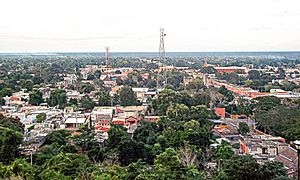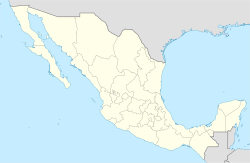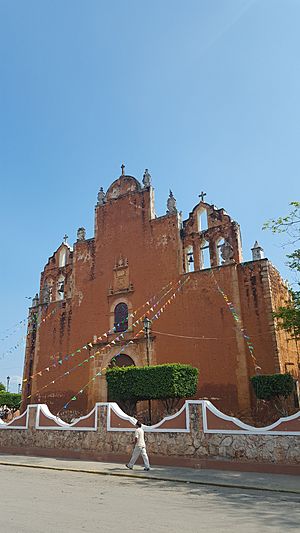Tekax facts for kids
Quick facts for kids
Tekax
|
|||
|---|---|---|---|
 |
|||
|
|||
| Nickname(s):
La Sultana de la Sierra
|
|||

Location of Tekax in Yucatan
|
|||
| Country | Mexico | ||
| State | Yucatán | ||
| Municipality | Tekax Municipality | ||
| Seat | Tecax | ||
| Elevation | 20 m (70 ft) | ||
| Population
(2010)
|
|||
| • Total | 25 751 | ||
| Demonym(s) | Tecaxican | ||
| Postal Code |
97970
|
||
| Prefix | 997 | ||
Tekax is a vibrant city in the Mexican state of Yucatán. Its full official name is Tekax de Álvaro Obregón. It serves as the main city for the Tekax area. The city is about 37 meters (121 feet) above sea level. It is located 115 kilometers (71 miles) from Mérida, the capital city of Yucatán.
Contents
What Does Tekax Mean?
The name Tekax comes from the Mayan language. It combines two words:
- Teʼ: meaning "place," "there," or "in that spot."
- Kʼáax: meaning "jungle" or "mountain."
So, Tekax means "There in the jungle."
A Look at Tekax's History
The exact date Tekax was founded is not known. However, we know that the area was home to the Maya people long ago. Before the Spanish arrived, this region was part of the Tutul Xiu kingdom. This kingdom was a powerful group of Maya people.
Ancient Maya in Tekax
The Tekax region has been lived in since ancient times. This was when the Maya culture began to grow in the Puuc area. We can still see proof of this at several old Maya sites. These include Chacmultún, Canahaltún, Chunmul, Xkichmook, Chacchob, and Chunconab. These sites show the unique Puuc style of Maya architecture. Some also show influences from the Chenes style found in Campeche.
Spanish Arrival and Growth
In the 16th century, a Spanish explorer named Alfonso López colonized the region. The Tutul Xiu leaders, who had broken up the Mayapán coalition, came down from the southern mountains. They founded the town of Maní and built other towns that paid tribute to it. One of these towns was Kax, built on the slopes of the mountains. All these towns together formed the Tutul Xiu chiefdom, with Maní as its main center.
Tekax's Changing Status
Over time, Tekax grew and changed its official status:
- In 1823, Tekax was given the title of Villa (a town with special rights).
- In 1841, it became a City.
- However, in 1922, it was changed back to a Town.
- In 1928, Tekax was named Ciudad Obregón by a special rule.
- Just two years later, in 1930, its name was changed to Tekax de Álvaro Obregón, which it is still called today.
Culture and Traditions
Tekax is rich in history and culture. You can see this in its old buildings and lively festivals.
Important Buildings
Some of the most famous buildings in Tekax are from the colonial period or built in that style:
- The Parish of San Juan Bautista: This church dates back to the 17th century.
- The Three-Story House: A unique and historic building.
- The Hermitage of San Diego: Another 17th-century religious building.
- The Chapel of the Eternal Father.
Fun Festivals
Tekax celebrates many traditional festivals throughout the year:
- Spring Festival: Held from April 18 to 22.
- Saint Bartholomew's Day: Celebrated from May 8 to June 1 in the town of Pencuyut. This includes rosaries, masses, and processions.
- San Juan Bautista (Saint John the Baptist): The patron saint of the city, celebrated in June.
- San Diego de Alcalá: Celebrated from November 8 to 13.
- Virgin of Guadalupe: Celebrated from December 4 to 15.
Historical Monuments to Explore
Tekax has many important historical sites, both architectural and archaeological.
Architectural Sites
These are buildings that show the history and style of the area:
- Ex-convent and Parish of San Juan Bautista (17th century)
- The Hermitage of San Diego (17th century)
- The Chapel of San Francisco
- The Chapel of the Eternal Father
Archaeological Sites
These are ancient Maya ruins that tell us about the people who lived here long ago:
- Chamultún
- Chuncanap
- Itzitz
- Nocacab
- Santa María
- Tzulay
- Xaya
- Kinil
- Tixhualahtun
- Chacchob
- San Diego
- Ticum
- Cotbé
See also
 In Spanish: Tekax de Álvaro Obregón para niños
In Spanish: Tekax de Álvaro Obregón para niños






